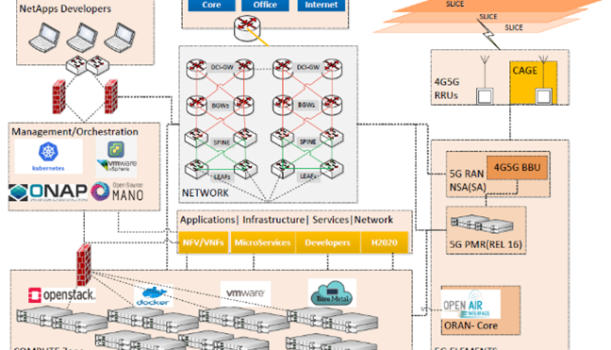5GASP primary objectives include establishing an Open Source Software (OSS) repository and a VNF marketplace for SMEs, offering examples and building blocks based on OSS. It also aims to foster a community of Network Application developers by providing tools and services that enable early validation and certification of 5G products and services. The focus lies on inter-domain use-cases, developing operational tools and procedures to support daily testing and validation activities, as well as ensuring the security and trustworthiness of third-party intellectual property rights (IPR) running in the project testbeds. One of the project’s testbeds is hosted in Romania, on the premises of the Orange 5G Lab from Bucharest.
ORO’s 5G Lab is located inside the CAMPUS Research Center of the University Politehnica of Bucharest and implements a full 5G Stand-Alone (SA) infrastructure, comprising 5G RAN, Core, Edge Computing and advanced SDN Network in the Datacenter. The testbed, represented in the figure below, is based on a combination of both open (based on OpenAirInterface open-source solutions) and commercial (3GPP Rel.16) network implementations. In the laboratory ORO is also implementing an advanced IP transport network (SDN in DC), a virtualization framework, based on OpenStack and Kubernetes and orchestration using OSM, a solution compliant with the ETSI MANO standards. The testbed is capable to provide multi-slices implementations, with QoS/QoE guarantee in the concurrent services implementation, as eMBB (1500Mbps DL/200MBpsUL) or URLLC (E2E one way delay <2.5 ms), based on 3GPP NSSAI parameters used for differentiation. Another advanced key component of the testbed is the Next-Generation SDN Data Centre, integrated IPFABRIC concept, open to be orchestrated, dynamic configuration and zero touch management within the E2E network slice and automated service deployment.

The Romanian testbed uses the 5G SA Compact Mobility Unit (CMU) CN solution from Nokia, which is running on a virtualized infrastructure in the Orange Datacenter. The solution integrates three main components that implement the 5G SA 3GPP defined Network Functions (NFs): the Cloud Mobile Gateway (CMG), the Cloud Mobility Manager (CMM), and the Authentication and Policy Control (APC).
In terms of the radio access network implementation, radio N78 band (with a allocated bandwidth of 100MHz) has been selected for the deployment of the 5G SA gNodeBs (gNBs). The Bucharest site consists of indoor NR cells, one of them being placed in a semi-anechoic chamber for advanced experiments in a controlled environment.
The Romanian testbeds implements the 5GASP NetApp onboarding architecture, which is providing to the NetApp Developers the framework for the domain requirements VNFication, developments and adaptation of onboarding procedures of the Applications on the 5GASP platform and targeted facilities, within the integration for Network Applications onboarding to the Network Applications catalogues, CI/CD framework testing pipeline for the target facility, Target facility deployment (Service Orchestration, CI/CD pipelines), NFVO, ETSI MANO onboarding and services information and Network Applications validation process.
From the architectural point of view, OSMv10 is the main actor that makes onboarding possible in the 5GASP framework, taking the role of orchestrator. From architectural view, the OSM is the integration point between the upper 5GASP service layer and the project facilities, including the Romanian testbed. OSM is connected to VIM accounts/tenants such as OpenStack, Kubernetes and by providing the VNF or CNF descriptors it is started the configuring activities of the VNFs/CNFs in corresponding NFVI.
In the figure below, it is presented the onboarding workflow between the different 5GASP architectural components (Services and facility orchestrators, testbeds, Network Applications) with respect to workflow implemented for the onboarding and connection to CI/CD services, a fully interactive process from NetApp developer point of view, configuring and testing a NetApp step by step within the target testbed.
One Network Application that has been already onboarded on the Romanian testbed is built by Neobility and address the problem of urban mobility with a mobile application that aggregates all the means of transport from the common ridesharing platforms in one single place for users’ convenience.



